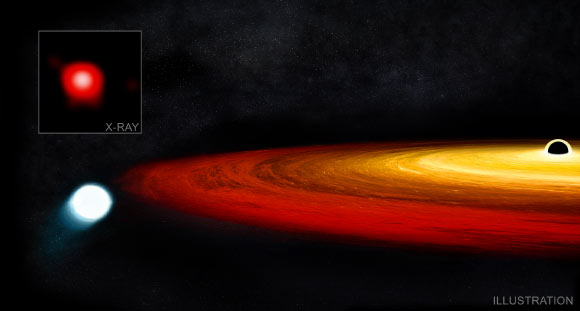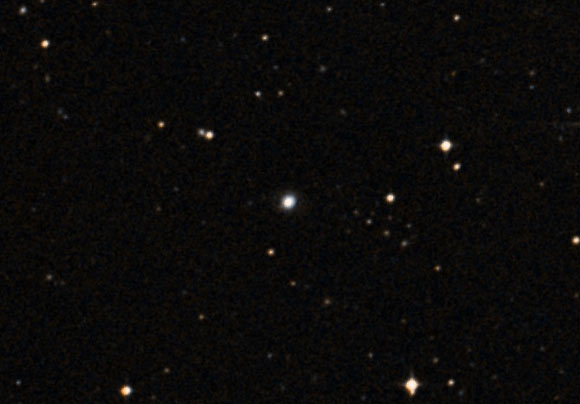Professor Andrew King from the University of Leicester has shown that periodic X-ray eruptions from a galaxy called GSN 069 could result from the core of a red giant star trapped in a very eccentric orbit around the galaxy’s central black hole.

Chandra and XMM-Newton data indicate that a white dwarf survived a close call with the central black hole in GSN 069. Image credit: NASA / CXO / CSIC-INTA / G. Miniutti et al / CXC / M. Weiss.
GSN 069, also known as 2MASX J01190869-3411305, is located approximately 250 million light-years away in the constellation of Sculptor.
Its central black hole has a mass about 400,000 times that of the Sun, putting it on the small end of the scale for supermassive black holes.
Once a red giant star was captured by the black hole’s gravity, the outer layers of the star containing hydrogen were stripped off and careened toward the black hole, leaving the core of the star — known as a white dwarf — behind.
“In my interpretation of the X-ray data the white dwarf survived, but it did not escape,” said Professor King, author of a paper published in the Monthly Notices of the Royal Astronomical Society: Letters.
“It is now caught in an elliptical orbit around the black hole, making one trip around about once every 9 hours.”

This image shows the galaxy GSN 069 (center). Image credit: Centre de Données astronomiques de Strasbourg / SIMBAD / DSS2.
Professor King analyzed data from two orbiting X-ray telescopes, NASA’s Chandra X-ray Observatory and ESA’s XMM-Newton.
“At its closest approach, about 15 times the radius of the black hole’s event horizon, gas is pulled off the white dwarf into an accretion disk around the black hole releasing X-rays which the two spacecraft are detecting,” the astronomer said.
“In astronomical terms, this event is only visible to our current telescopes for a short time — about 2,000 years, so unless we were extraordinarily lucky to have caught this one, there may be many more that we are missing elsewhere in the Universe.”
“Such encounters could be one of the main ways for black holes the size of this one to grow.”
Professor King predicts that the white dwarf has a mass of only 0.21 solar masses.
If the white dwarf was the core of the red giant that was completely stripped of its hydrogen, then it should be rich in helium. The helium would have been created by the fusion of hydrogen atoms during the evolution of the red giant.
“It’s remarkable to think that the orbit, mass and composition of a tiny star 250 million light years away could be inferred,” Professor King said.
“Because the white dwarf is so close to the black hole, effects from the theory of general relativity mean that the direction of the orbit’s axis should wobble, or precess.”
“This wobble should repeat every two days and may be detectable with sufficiently long observations.”
_____
Andrew King. 2020. GSN 069 – A tidal disruption near miss. MNRASL 493 (1): L120-L123; doi: 10.1093/mnrasl/slaa020







